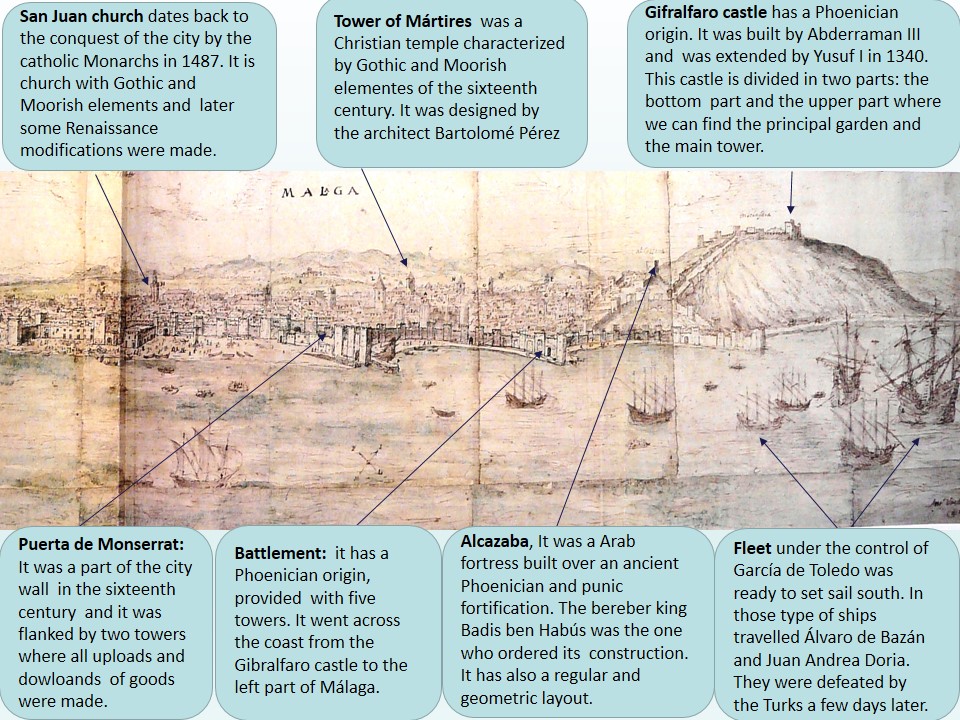MÁLAGA (Anton Van den Wyngaerde, 1564)
Anton Van den Wyngaerde is the author of this image. He was considered the most famous topographer in the Rennaissance, because his most important aim was the cartographic precision of the landscape representation. During the sixteenth century, he made several paintings of some relevant cities in Spain, commited by King Phillip II, who wanted an exact and complete description of the geography of Spain.
Málaga is the city that we are going to study. It is situated in the south of Spain and particularly located between the sea and the mountains. These two factors influenced a lot in its development. The image represents a panoramic perspective from the sea focusing on the fleet of García de Toledo and the city in the background. It is possible to distinguish the landscape from the Castle of Gifralfaro to the proximal village of Torremolinos. In those times, Málaga had a population of around 15.000 inhabitants and was a very important commercial city.
Gifralfaro Castle is placed at the top of a hill in the right margin. It was built by Caliph Abderramán III and in 1340 the Nasrid king Yusuf I remodelled and transformed it in a luxurious castle. After that, the Catholic Monarchs used it to take it as their vacation residence. The origin of this construction is primarily a refuge for the troops and also to protect the Alcazaba as it had a better view of the city and the sea. Further down we can see the Alcazaba or fortress. This area is connected to the rest of the city by two roads, one along the hill which has a battlement and another road going to the sea. The fortress was formerly a Phoenician building but then reconstructed with limestone by the bereber king of Granada, Badis ben Habús. After that work, its function was aimed to be rather defensive and it was the residence of Governor and knights.
Apart from that, Málaga had with a big city wall to protect itself from any danger. This wall had a Phoenician origin although it was rebuilt several times. It went across the coast from the Gibralfaro castle to the other side of the city. Moreover, the city wall had a number of sea gates with the aim of getting the materials from the commercial ships easily. Not only the battlement, but also watchtowers which were made in sixteenth century, can be seen in the picture. Their purpose was the defence of the territory against the attacks of Moorish pirates.
Other important elements and characteristic parts of the city are displayed such as the or fortress. Apart from that, the author of the painting wanted to show us the urban skyline, formed by the city wall and many religious buildings such as churches, convents and the cathedral. Among the religious buildings that we can appreciate in the picture we can mention the Mártires Church, made in Moorish-Gothic style. It is located on the city centre and it was originally built by Catholic Monarchs. In addition, we can see the church of San Juan situated on the left, whose style is the same as the previous one, as it was built in the same era with pointed arches on pillars and a tower that was finally completed in the year 1543.
To finish with, in the painting by Anton Van den Wyngaerde, we can see an Arab spring, but it was not until 1586 that a better and modern one was built. This caused a mayor delay in the commercial development of Málaga, because before that it was so difficult to embark on that área. Wyngaerde also portrayed the urban structure by showing the different parts of the city, from the center to the outskirts. This is why the painting was made in 1564 and is considered a very important graphical document for knowing the historical, economic and social evolution of Málaga.
Paula Martínez Rueda

